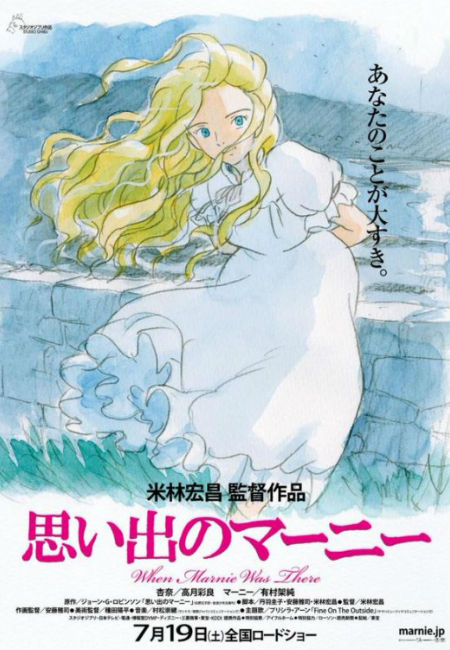
As Anna Sasaki (Sara Takatsuki) knows only too well, it is never easy being the outsider.
Remarking in the first luminously-rendered scenes of When Marnie Was There, the light, colour and attention to detail confirming that Studio Ghibli’s breathtakingly beautiful artistic trademarks are very much in place for what may come to be their last feature film, that “in this world there is an visible magic circle, a inside and an outside, and I am outside”, she is all too painfully aware of which side of the fence she falls on.
Sitting apart from her fellow school students while they sketch in a park full of playing children and laughter, she is morose, introverted, a closed-up shell of a girl who, though loved and cared for by her doting foster mother Yoriko (Nanako Matsushima) – the foster father is never seen though he’s referred to a number of times – feels an innate sense of loneliness and emotional isolation that no amount of attentive care seems able to erase.
Hers is a world apart, something that becomes an outer, physical manifestation as much as an aching inner one when she is sent away from Sapporo to her aunt and uncle’s place in rural Hokkaido, the northernmost of Japan’s four main islands, with all the best intentions in the world by Yoriko, who clearly hopes their time apart as mother and daughter will be a healing one that will restore Anna back to the happy girl she was before the death of her parents when she was five.
Ostensibly designed as a time to repair her asthma, which strikes up virulently whenever Anna is emotionally troubled, a near constant state of affairs accompanied by railing about how much she hates herself, the stay with her endlessly upbeat, ruddy-faced aunt Setsu (Toshie Negishi) and gleefully-unaware, tinkering uncle Kiyomasa (Susumu Terajima) ends up being the sort of transformative experience neither Anna nor a pensive Yoriko could have predicted.
Based on the eponymous 1967 book by Joan G. Robinson, with the story transposed from rural England to country Japan so adroitly that it’s easy to assume it was always the setting for Anna’s inner journey to emotional wholeness, When Marnie Was There, directed by Hiromasa Yonebayashi (The Secret World of Arrietty) is a film adaptation as profoundly and pleasingly realised as any fan of the source novel could hope for.
It maintains Studio Ghibli’s ongoing commitment to telling stories that eschew the flippant and the glib, though there remains still a super-magical quality that lends this most substantial of emotional journeys rooted in the gritty and painful realities of real life a happily otherworldly air, in favour of dwelling in those dark places many of us would prefer to ignore.
The thing is that for people suffering like Anna, and the film makes it abundantly clear over and over that though she is sweet and polite, she is not in a good place, the oppressive inner swirl of regret, rejection and sense of betrayal is near impossible to wish away.
It is only when Anna meets the mysteriously mischievous, long golden-haired Marnie, who somewhat impossibly, seems to live in an abandoned, anglicised mansion Marsh House which has been all but boarded up and abandoned for many years, that she begins to come alive bit by bit, her appreciation of what it means to be truly connected to another person reawakened after a long period of self-inposed protective dormancy.
Anna’s mind and dreams tell her that this girl, who becomes her friend in ways she never knew was possible, cannot possibly be alive here and now, her world far too removed from the modern day but such is her need for belonging and acceptance that she pushes these thoughts aside in favour of embracing everything that Marnie has to offer from late night, lavishly-catered parties to impromptu moonlit parties by the bay.
When Marnie Was Here keeps this balancing act between the real and the might-be-real in perfect tension throughout the film until the truth of what happened both in the past and in the here-and-now is brought into sharp, freeing relief in the film’s rather busy climactic final third.
But the ending, though touching and a fitting resolution of Anna’s tale, is almost not the point with the majority of the film’s running time given over to exploring why Anna is the way she is, if it possible to find healing, and what that healing might look like if it is ever to arrive.
You know that Marnie is integral to this unravelling and re-animation of Anna but not quite how; only that without the puckishly whimsical, headstrong young girl from the mansion that Anna will never quite manage to surmount the pain and loss of her early childhood.
The artwork is, as always, a joy to behold, so photo-realistic that you feel, much like Anna herself, that you could simply walk along the beach, or pick tomatoes with her aunt Setsu or row the boat with Anna and Marnie out onto the moonlit bay.
Or, in a sign that Studio Ghibli has lost none of its power to move, surprise and entrance us, that you could walk with Anna through the dark places and those more fully lit, and come out the other side every bit as affirmative about life and its many hills and troughs as the once hidden away from life young lady herself.